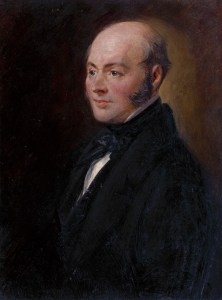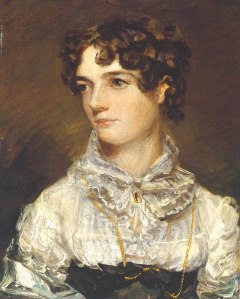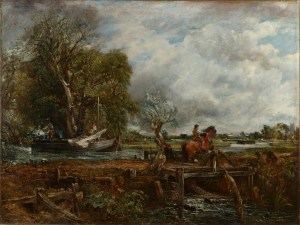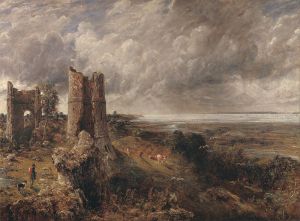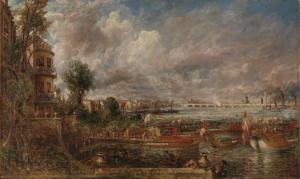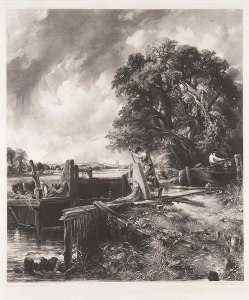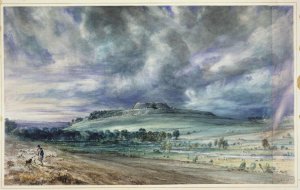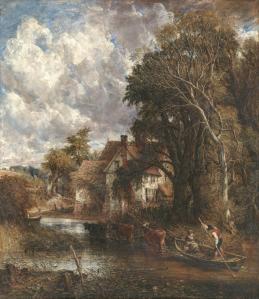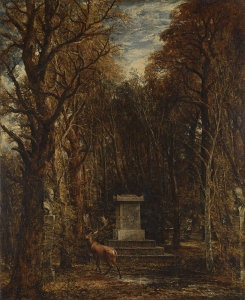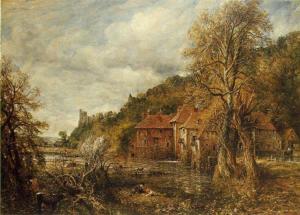Until 13th February 2022, The Royal Academy of Arts is looking back at the work of one of their graduates, John Constable. Rather than look at all of his paintings, the Academy has chosen examples from the final twelve years of Constable’s life, illustrating his more radical and expressive side. Between 1825 and his death, Constable experimented with plein air painting, dramatic weather phenomena, enthusiastic brush strokes, and the possibilities of printmaking. Despite his connection with the Academy, the RA has never staged a major retrospective of Constable’s work until now.
John Constable was born at East Bergholt House in Suffolk on 11th June 1776 to Golding (1739-1816) and Ann (Watts) Constable (1748-1815). His older brother was intellectually disabled, so Constable’s parents expected John to work in the family corn business. Instead, Constable’s younger brother Abram took over the running of the mills, allowing Constable to wander the Suffolk and Essex countryside making amateur sketches. Constable later said the scenes “made me a painter, and I am grateful.”
After persuading his father to let him pursue a career as an artist, Constable entered the Royal Academy Schools as a probationer in 1799. After a year of studying the Old Masters and attending drawing classes, Constable officially became a Student at the Schools. After graduating, he turned down the position of drawing master at Sandhurst because he wanted to focus on producing art rather than teaching. Instead, Constable concentrated on his first submission to the Royal Academy’s Annual Exhibition of 1802 (now known as the Summer Exhibition).
In 1816, Constable married Maria Bicknell (1788-1828) at St Martin-in-the-Fields, London. Maria’s father, a solicitor to King George IV (1762-1830) and the Admiralty expressed his concern that Constable had no money to his name. Yet, before the marriage went ahead, both of Constable’s parents died, leaving him one-fifth of the family business.
Maria’s poor health was a persistent worry for Constable, but he continued with his painting and participated annually in the Royal Academy’s exhibitions. In 1819, he was elected an Associate of the Royal Academy and exhibited his first “six-footer”. The term refers to six monumental landscapes depicting the River Stour, each painted on a six-foot canvas. Fellow painter Charles Robert Leslie (1794-1859) predicted the first of the six, The White Horse, would be “on many accounts the most important picture Constable ever painted.”
Every year, people admired, talked about, and eventually purchased one of the “six-footers”, including The Hay Wain (1821), which now resides at the National Gallery and remains one of Constable’s most famous paintings. The success continued until 1826 when Constable exhibited his final “six-footer”, The Leaping Horse. It was the only artwork in the series that failed to sell during Constable’s lifetime.
The RA displayed The Leaping Horse next to a full-size sketch that Constable made in situ. Several small drawings also show the artist’s experimentation with elements of the landscape. In the sketch, a small tree stands in front of the horse and rider, but in the final painting, the tree is at the rear. The horse, which leaps over one of the barriers erected along the river path, was walking in Constable’s preparatory work. There is a visible mark where Constable removed one of the trees in the background. He did this after failing to sell the painting at the 1825 Annual Exhibition.
After failing to sell The Leaping Horse, Constable directed his attention away from the River Stour towards lanes, dells and panoramic vistas. Whilst no longer painting canals, Constable did not avoid water scenes. This is evident in his 1826 Annual Exhibition piece, The Cornfield. Constable preferred the name The Drinking Boy to describe this painting, which shows a young shepherd boy quenching his thirst in a pool of water. The boy’s dog waits patiently for his master while the sheep carry on up the path.
The lane depicted in The Cornfield is Fen Lane, which leads from Constable’s childhood home in East Bergholt towards Dedham in Essex. Constable frequently ran along the pathway on his way to and from school, passing through cornfields along the way. Constable grew up surrounded by similar scenes, which explains his preference for these idyllic landscapes and picturesque views.
When Constable’s wife started displaying symptoms of tuberculosis, he purchased lodgings in Brighton where he thought the sea air would help Maria’s condition. The family spent their summers in Brighton between 1824 and 1828, during which time Constable frequently studied and painted the sand, sea and sky. One painting from this period, Chain Pier, Brighton, was exhibited at the 1827 Annual Exhibition.
Erected in 1823, the Royal Suspension Chain Pier was the first major pier in Brighton. It was designed by Captain Samuel Brown of Netherbyres (1776-1852), intending to start boat trips to Dieppe in France. It is fortunate that Constable and other artists captured the pier on canvas because a storm demolished it in 1896.
When not in Brighton, the Constable family lived in Hampstead, London, from where Constable frequently returned to familiar places of his childhood. One such place was Dedham Vale, which Constable painted for the 1828 Annual Exhibition. Constable depicted the view from Gun Hill in Suffolk, which reveals Dedham church in the far distance. Many believe Constable based Dedham Vale on a painting by Claude Lorrain (1600-82) called Hagar and the Angel. The art collector George Beaumont showed Constable the painting before he joined the Royal Academy Schools. Since Beaumont (1753-1827) died a year before Constable painted Dedham Vale, its similarities to Lorrain’s work suggests it is a tribute to the late collector.
The success of Dedham Vale earned Constable the position of a full Royal Academician in 1829, something for which he had yearned for a decade. Unfortunately, Maria passed away in 1828 and did not get to see her husband achieve his goal. Greatly affected by her death, Constable chose to wear black for the rest of his life. In a letter to his brother, he wrote, “hourly do I feel the loss of my departed Angel—God only knows how my children will be brought up…the face of the World is totally changed to me.” As well as continuing with his artwork, Constable needed to care and provide for his seven children: John Charles, Maria Louisa, Charles Golding, Isabel, Emma, Alfred, and Lionel.
The turmoil and distress of Constable’s mind following his wife’s death are evident in his paintings from this period. For the 1829 Annual Exhibition, Constable painted Hadleigh Castle, a ruined fortification in Essex, overlooking the Thames Estuary. He first visited the castle in 1814, where he produced several sketches. From these drawings, he produced a six-foot oil painting of the castle, with stormy clouds in the background. Constable often studied and painted clouds in the early years of his marriage, but they were usually white and fluffy. The clouds in Hadleigh Castle are dark and foreboding, suggesting life without Maria was dark and gloomy.
Constable often referred back to his old sketches when preparing large paintings for the Annual Exhibitions. In 1817, Constable witnessed the opening of Waterloo Bridge in London, commemorating the second anniversary of the Battle of Waterloo. Over the following years, Constable produced many drawings and oil sketches of the bridge and the festivities on opening day.
For the 1832 Annual Exhibition, Constable produced a large oil painting showing the Prince Regent (George IV) boarding the Royal barge at Whitehall stairs, with Waterloo Bridge in the background. As a royalist, Constable wanted to capture the event and the Royal family’s involvement for posterity. In the sky, grey clouds form, either indicating the weather on the day of the event or reflecting Constable’s mental state following the death of his wife.
Many of Constable’s paintings contain bold touches of red to highlight figures or lead the viewer’s eye to the main focus of the artwork. It is unlikely that everyone Constable depicted in his landscapes wore red, but it helped bring the picture to life. When displaying paintings for the Annual Exhibition, some artists added final touches to their canvases. On the wall next to The Opening of Waterloo Bridge hung J.M.W Turner’s (1775-1851) seascape Helvoetsluys. When Turner noticed the red highlights in Constable’s painting, he added a blob of red paint in the centre of his work to draw everyone’s attention away from the neighbouring artwork.
During the early 1830s, Constable began teaching life drawing at the Royal Academy Schools. He also started experimenting with other media, such as watercolour and printmaking. Whilst the majority of Constable’s submissions to the Annual Exhibitions were oil paintings, he occasionally submitted watercolours. Constable discovered printmaking, particularly mezzotints, a powerful way of expressing light and shade. Using his wife’s inheritance money, Constable collaborated with David Lucas, a British mezzotinter, to create 40 prints of his landscapes. Trial and error meant several versions of each design were printed before settling on the final 40 to publish in a folio. Unfortunately, the project was not a financial success, and Constable never saw the money he spent again.
In 1834, illness prevented Constable from working on an oil painting for the Annual Exhibition, so the only piece he submitted was a watercolour called Old Sarum. The scene is based on Constable’s sketches of Old Sarum, a ruined and deserted site of the earliest settlement of Salisbury in Wiltshire. The old settlement is visible on a mound in the distance while grey clouds billow overhead. Constable added a strip of paper on the righthand side to include the hint of a rainbow. Old Sarum is one of the 40 landscapes Constable used in his English Landscape series of mezzotints.
Between 1833 and 1836, Constable delivered a series of lectures about the history of landscape painting. He wished to raise the status of landscapes, which were once considered superior to other art forms but no longer popular. Throughout his career, Constable painted scenes that interested him rather than what other artists and buyers preferred. Whilst this hindered his attempts to become a Royal Academician for many years, it has earned Constable recognition for revolutionising the genre of landscape painting. Since many of his paintings depict the area he lived and grew up in, Suffolk is now known as “Constable Country”.
For the 1835 Annual Exhibition, Constable briefly returned to his earlier style of painting. The Valley Farm, also known as Willy Lott’s House after the landowner, depicts a scene on the River Stour, not far from Constable’s childhood home. It is based on two of his previous paintings of the area, The Ferry (1814) and Willy Lot’s House from the Stour (1816-18). Constable reworked the landscape to make it more expressive than earlier versions and modified the house so that it appeared grander. Whilst Constable felt pleased with the result, critics disapproved of the artist’s adjustments and accused Constable of ruining the natural landscape. Nonetheless, Constable had a buyer before the opening of the Exhibition. The self-made businessman Robert Vernon (1774-1849) paid Constable £300, the largest sum Constable had received for a painting.
Despite returning to some of his earlier themes, Constable continued experimenting with watercolour, as seen in his painting of Stonehenge. The painting, which featured in the Royal Academy’s final Annual Exhibition at New Somerset House in 1836, combined a dramatic sky with a well-known British landmark. Since painting Hadleigh Castle and Old Sarum, Constable’s fascination with ruins grew. These decaying man-made structures succumbing to the elemental power of nature, metaphorically express Constable’s emotions following his wife’s deaths along with two close friends, Archdeacon John Fisher (1788-1832) and John Dunthorne (1798-1832).
Alongside Stonehenge, Constable displayed Cenotaph to the Memory of Sir Joshua Reynolds. Due to poor health, this was the only oil painting Constable completed for the exhibition. It depicts the memorial to Sir Joshua Reynolds (1723-1792), the first President of the Royal Academy, that Sir George Beaumont built in the grounds of his home at Coleorton Hall in Leicestershire. Beaumont planned to erect several monuments to friends and people he admired but died before the project could get underway. In some ways, Constable’s painting is also in memory of Beaumont, who helped him become a professional artist.
Constable visited Coleorton in 1823, where he made pencil drawings of the monument. He only started working on the oil painting ten years later and just finished it in time for the 1836 Annual Exhibition. As well as the cenotaph, Constable included two busts in tribute to the Old Masters, Michelangelo and Raphael. In one of his last lectures, Constable praised Raphael’s artwork. He also called the Royal Academy the “cradle of British art” and received cheers from attending students.
In the early hours of 1st April 1837, Constable died from heart failure at the age of 60. He was buried beside his wife in the family tomb in the graveyard of St John-at-Hampstead Church. His children inherited all their father’s remaining sketches and unsold paintings, which they kept for the rest of their lives. The only artwork they relinquished was Arundel Mill and Castle, which Constable was working on at the time of his death. He had intended to submit it to the Royal Academy’s first Annual Exhibition in Trafalgar Square. Since it looked almost finished, Arundel Mill and Castle was displayed as Constable intended.
In 1888, Constable’s last surviving child, Isabel (1823-1888), gave the remains of her fathers work (95 oil paintings, 297 drawings and watercolours and three sketchbooks) to the South Kensington Museum (V&A). Since then, the artworks have been sold and distributed between several art galleries. The Late Constable exhibition marks the first time the Royal Academy has staged a major retrospective of Constable’s work, bringing together twelve years worth of paintings, drawings and prints. Not only does the exhibition demonstrate Constable’s artistic abilities, but it also reveals how grief and emotions play a part in creative output. Whilst the death of Constable’s wife was tragic, it changed the way Constable tackled his paintings, allowing his audience to see a more versatile side of the artist.
Constable painted the scenes he wanted to paint. The landscapes held meaning for Constable, and he did not concern himself with attempting to please the audience by conforming to modern tastes. Late Constable tells a story about an artist struggling with grief whilst striving to achieve the same accolades as his peers. The Royal Academy is finally giving Constable the recognition he deserved during his career through this retrospective exhibition.
Late Constable is open until 13th February 2022 in the Gabrielle Jungels-Winkler Galleries at Burlington Gardens, Royal Academy of Arts. Tickets cost £19, but Friends of the RA may visit for free. All visitors must book tickets in advance.
My blogs are available to listen to as podcasts on the following platforms: Anchor, Breaker, Google Podcasts, Pocket Casts and Spotify
If you would like to support my blog, become a Patreon from £5p/m or “buy me a coffee” for £3. Thank You!

